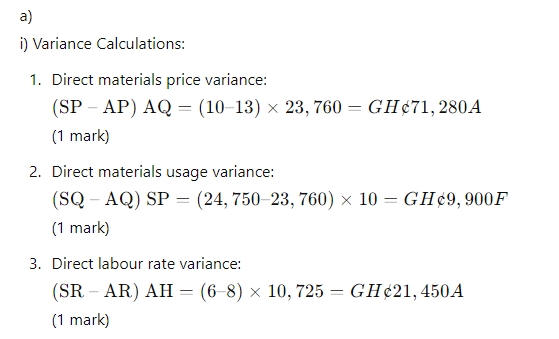- 20 Marks
Question
a) Public Sector in Ghana includes the Metropolitan, Municipal and District Assemblies
(MMDA’s) and the Ministries, Departments and Agencies (MDA’s). The private sector
dominates in terms of numbers and are significantly different in operations from the public
sector.
Required:
In reference to the above statement, explain FOUR (4) key differences between a private
sector entity and a public sector entity. (10 marks)
b) Konka Ltd produces a product – “the telescope”.
Actual results for the period were:
Production: 430 units made
Materials: 1,075 kg were used.
1,200 kg of materials were purchased at a cost of GH¢17,700
Direct labour: 1,700 hours were worked at a cost of GH¢14,637
Variable production overheads expenditure: GH¢3,870.
The standard cost card for the product is as follows:
GH¢
Direct material 2 kg x GH¢15 30
Direct labour 4hrs x GH¢8.50 34
Variable overhead 4hrs x GH¢2.00 8
The cost card is based on production and sales of 450 units in each period.
The company values its inventories at standard cost.
Required:
Calculate the following variances for Konka Ltd:
i) Material price variance
ii) Material usage variance
iii) Labour rate variance
iv) Labour efficiency variance
v) Variable overhead expenditure variance
(10 marks)
Answer
a)
Key Differences between a Private Sector Company and a Public Sector Organization:
| Aspect | Private Sector (Limited Company) | Public Sector Organization |
|---|---|---|
| Ownership | Shareholders | The people (through the government) |
| Management | The owners or managers appointed by owners | Government appointees |
| Objectives | To make a profit | To provide a service |
| Funding | From shareholders or borrowing from financial institutions | By grants from the government |
| (10 marks) |
b)
i) Materials Price Variance
1,200 kg of materials should cost (1,200 kg × GH¢15) = GH¢18,000
Actual cost = GH¢17,700
Materials price variance = GH¢300 Favorable (F)
(2 marks)
ii) Materials Usage Variance
430 units of output should use (430 units × 2 kg) = 860 kg
Actual usage = 1,075 kg
Materials usage variance in kg = 215 kg Adverse (A)
Standard price per kg of materials = GH¢15
Materials usage variance = 215 kg × GH¢15 = GH¢3,225 Adverse (A)
(2 marks)
iii) Labour Rate Variance
1,700 labour hours should cost (1,700 hrs × GH¢8.50) = GH¢14,450
Actual cost = GH¢14,637
Labour rate variance = GH¢187 Adverse (A)
(2 marks)
iv) Labour Efficiency Variance
430 units of output should take (430 units × 4 hrs) = 1,720 hrs
Actual hours worked = 1,700 hrs
Labour efficiency variance in hours = 20 hrs Favorable (F)
Standard rate per labour hour = GH¢8.50
Labour efficiency variance = 20 hrs × GH¢8.50 = GH¢170 Favorable (F)
(2 marks)
v) Variable Overhead Expenditure Variance
1,700 hours should cost (1,700 hrs × GH¢2) = GH¢3,400
Actual cost = GH¢3,870
Variable overhead expenditure variance = GH¢470 Adverse (A)
(2 marks)
- Topic: Standard Costing and Variance Analysis
- Series: JULY 2023
- Uploader: Joseph

